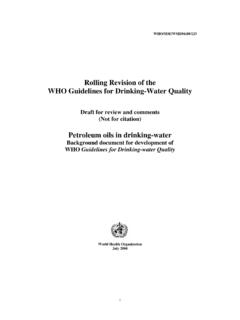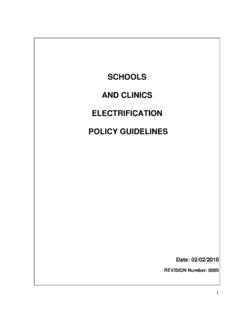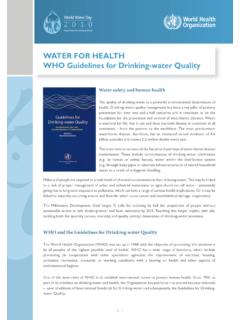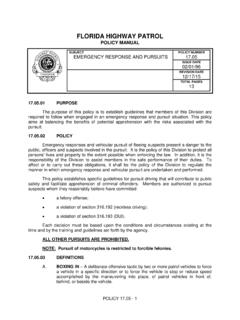Transcription of HID Inspection Guide Offshore - Health and Safety …
1 HID Inspection Guide Offshore Inspection of Safety Critical Element Management and Verification Contents Summary Introduction Action Background Organisation Appendix 1: Additional References Appendix 2: SCE management policy Appendix 3: SCE and verification leadership Appendix 4: SCE management process Appendix 5: Management of changes to SCEs Appendix 6 SCE maintenance Appendix 7: Competent advice on SCEs Appendix 8: SCE performance review Appendix 9: Verification arrangements Appendix 10: Verification planning Appendix 11: Verification effectiveness Appendix 12: Performance standards Appendix 13: Competence and independence of ICPs Appendix 14: Requirement to revise the verification scheme Appendix 15: Multiple ICPs Appendix 16: Re-tendering of ICP contracts or change by duty holder Appendix 17: Performance assessment criteria Summary This Inspection Guide (IG) describes current key topic areas on SCE management and Verification that inspectors will consider when they inspect Offshore installations and duty holders.
2 The document sets out the success criteria to assess and rate duty holder performance. Information on regulations, technical standards and other sources of guidance is also provided. Introduction The aim of this IG is to provide information and guidance to Offshore inspectors to support the delivery of consistent and effective Safety critical element (SCE) management and assurance. It does this by highlighting current key areas to be covered during inspections, providing a framework for inspectors to judge compliance, assign performance ratings, and decide what enforcement action to take Page 1 of 30 should they find legislative breaches. In doing so, it complements HSE s Enforcement Policy Statement (EPS) and Enforcement Management Model (EMM). Historically, major accidents Offshore have resulted from multiple failures in major-hazard risk control measures.
3 In the UK these risk control measures have been defined in the Safety Case Regulations, as SCEs and include hardware as well as Safety critical computer software. To meet HSE s goal of avoiding catastrophe these SCEs must be correctly identified, adequate in performance and dependable when required. Critical to the control of major hazards is the correct identification of the major hazard risk control measures (SCEs) and the performance required of them. In addition, a management system must be put in place to ensure that the SCEs are effective and dependable at all times and their operational status known. The Safety case regulations require duty holders of Offshore installation to appoint Independent and Competent Persons (ICP) to verify the suitability of these major hazard risk control measures. The process whereby ICPs ascertain the suitability of SCEs is known as verification within the UK Offshore industry.
4 This IG provides information and guidance to ED Offshore inspectors on what constitutes SCE Management and Verification to aid the delivery of consistent and effective Inspection of such arrangements. The assessment and Inspection of SCE management involves examining a broad range of management elements. These include policy, organisation (including roles and responsibilities), hazard identification, risk analysis, risk control measures, monitoring and review. Risk control is achieved through the maintenance and Inspection of SCEs to ensure their correct operation, management of change and the management of occasions when the SCEs are impaired. The assessment and Inspection of the Verification arrangements involves ensuring that the activities undertaken by the Independent Competent Persons to verify the SCEs and Verification management arrangements are fit for purpose This IG can also be used by Offshore operators to prepare for inspections and to better understand the intervention plans drawn up for their operations by HSE.
5 In addition, it can be used as a tool to help operators assess their own performance, for example, in carrying out gap analyses against the success criteria. This will enable operators to proactively identify and take steps to rectify any potential weaknesses in their arrangements for SCE Management and Verification. The SCE management section of this IG may also be used to assist Safety case assessment in this area. The following are the key areas covered within this IG. 1. SCE management policy Page 2 of 30 2. SCE and Verification leadership commitment 3. SCE management process 4. Management of changes to SCEs 5. SCE maintenance 6. Competent advice on SCEs (provision of Technical Authorities, TA) 7. SCE performance review 8. Verification arrangements 9. Duty holder s Verification planning 10. Verification effectiveness 11. Performance standards 12. Competence and independence of the ICP 13. Revision of the Verification scheme 14.
6 Multiple ICPs 15. Re-tendering of ICP contracts and change of duty holders Action There are a number of different models used for delivering SCE management. They all must have the following, well known, elements in place: Policy to define what is required the objectives; Organisation / planning ensure resources, role and responsibilities etc are in place to enable the above objectives to be met; Implementation how the above is delivered contained in procedures / processes; Do the carrying out of the processes / procedures defined above Monitoring / Review have the processes / procedures implemented the objectives in the policy have you done what you said you would do and are the results what you want? Research has indicated (RR756) that it is not necessarily the way an operation is organised that achieves success, but rather the rigour that the organisation exhibits in implementing its chosen way of operating.
7 For example, not whether they have in house or contracted out TAs but rather can they obtain good competent advice and do they use it well? This Guide attempts to outline in Appendix 2, what is required from an organisation rather than how to organise the management of major accident hazards are the outputs of organisation suitable and sufficient and pursued in a rigorous manner? The problem comes in defining rigour and whether the rigour expressed by an organisation (operator) is suitable and sufficient to manage major hazards. Research report RR756 tries to overcome this by giving a table of aspects of rigour (reproduced in Appendix 3). It is suggested that the approach adopted in assessing the topics given below is that the rigour in each of the key elements above (plan-do-monitor) is assessed. In an attempt to help with what is suitable and sufficient for the key topic areas listed above, benchmarks or norms have been defined.
8 It is expected that an Page 3 of 30 operator will meet these benchmarks. A number of these benchmarks refer to, or draw upon, information from other Inspection Guides. Many of these topics, if not all, can be undertaken via office visits. However, it is likely that covering all the topics would take a day or two. It is envisaged that undertaking examinations in these Inspection topic areas over a 2 to 3 year rolling programme would ensure that the Inspection expectations given in SPC/ENF/183 would be met. In addition, the SCE management topics may assist in Safety case assessment in this area. Critical success criteria are listed under the Inspection topics (see appendices); these cover the key issues that inspectors should consider when carrying-out inspections against each core intervention issue. In some instances, not all of the success criteria will apply, so inspectors should make a judgement regarding which of these are relevant in each case.
9 If the relevant success criteria cannot be met, inspectors should assess how serious the consequences of failure to comply could be. This will inform their decision making in terms of the performance ratings that they assign and the enforcement action they take (if any) based on the findings of the Inspection . When carrying out inspections covered by this guidance inspectors should: check the key issues against their success criteria in Appendices 2 to 16; use the generic performance descriptors in Appendix 9 to: determine the appropriate performance rating; and the initial enforcement expectation to use alongside the EMM. consider how and when the issues raised during an Inspection are to be closed out and recorded using the COIN issues tab; assess the extent to which senior management leadership influences front-line Safety ; and where occupational Health , Safety and welfare concerns are encountered during an Inspection , deal with such issues as a matter of routine and apply existing standards to determine what action to take in each case according to HSE's EPS and EMM.
10 Inspectors should use the HID generic performance descriptors to determine the appropriate performance rating for each of the four core intervention issues covered by this IG. The appendices also give guidance on the initial enforcement expectation and should be used alongside the Enforcement Management Model (EMM). The local factors that apply in each case will ultimately determine the whether there should be any enforcement action. Consideration also needs to be given as to how and when the issues raised during an Inspection should be closed out. Inspectors must adhere to the relevant operational guidance ( on use of the COIN issues tab). Background Relevant Legislation Page 4 of 30 The management of SCEs and their verification is driven by the following regulations:- The Offshore Installations ( Safety Case) Regulations 2005 The Offshore Installations (Prevention of Fire and Explosion, and Emergency Response) Regulations 1995 (PFEER) The Offshore Installations and Wells (Design and Construction, etc.)

















